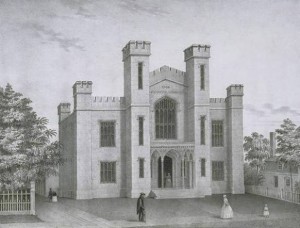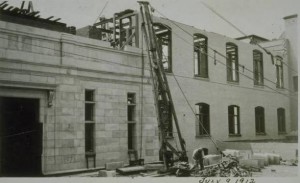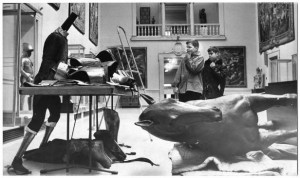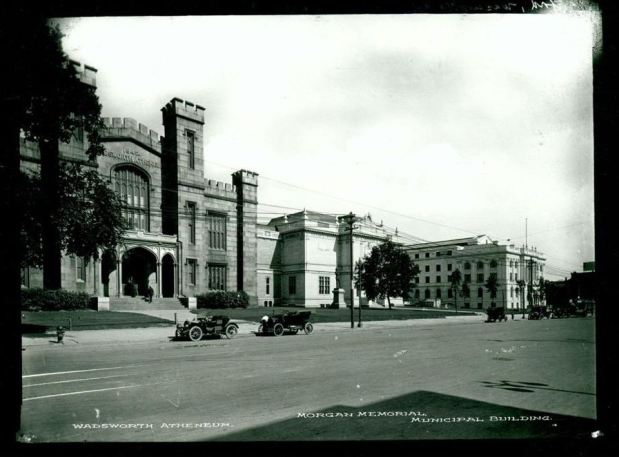By Aileen D. Bastos
Daniel Wadsworth, one of the first major arts patrons in the United States, founded the Wadsworth Atheneum Museum of Art in 1842. Today, it is the oldest, continuously operating public art museum in the US.
Its collections of nearly 50,000 works of art span 5,000 years and feature drawings, paintings, sculptures, and decorative arts. On display, and in storage, are Greek and Roman antiquities; European decorative arts; Baroque and Surrealist paintings; Hudson River School landscapes; European and American Impressionist paintings; modernist masterpieces; Ballets Russes costumes and drawings; American colonial furniture and decorative arts; the Samuel Colt firearms collection; costumes and textiles; African American art and artifacts; and contemporary art.
Building the Museum, Inside and Out

E.B. & E.C. Kellogg, Wadsworth Atheneum, Main Street, Hartford, ca. 1842-1848, lithograph – Connecticut Historical Society and Connecticut History Illustrated
The Wadsworth Atheneum is comprised of five connected buildings. The first is the 1844 Gothic Revival Wadsworth building, designed by architects Ithiel Town and Alexander Jackson Davis. It originally housed an art gallery, the Connecticut Historical Society, and the Young Men’s Institute (which later became the Hartford Public Library), and the Natural History Society. The second building, the Tudor Revival Colt Memorial, built in 1910, and the third, the Renaissance Revival Morgan Memorial, constructed from 1910 to 1915, were designed by Benjamin Wistar Morris and provided additional space for the growing fine arts collection.
The Avery Memorial opened in 1934 and was the first American museum building fashioned in the International Style. By 1964, the institutions not affiliated with the art museum had moved to other Hartford locations. When the Goodwin building, designed in a late modernist style, opened to the public in 1969, the entire facility was devoted to the fine arts.
Growing the Collection
The Wadsworth Atheneum’s art gallery developed slowly during its early years. The collection consisted mostly of history paintings, portraits, and American landscapes by artists such as John Trumbull, Thomas Cole, and Frederic Church, along with examples of Victorian era sculpture. The museum entered a period of rapid growth in 1889 when the Goodwin and Morgan families spearheaded a public fundraising campaign for a renovation and expansion program. In 1905, the museum received a generous donation when Elizabeth Hart Jarvis Colt bequeathed over 1,000 objects—including Hudson River School paintings, decorative works, and the firearms collection of her late husband Samuel Colt—as well as funds for the construction of the Colt Memorial.

The eastern extension of Morgan Memorial, 1912 – Connecticut Historical Society and Connecticut History Illustrated
In 1907 Hartford native J. Pierpont Morgan offered to build the Morgan Memorial, and in 1917, JP Morgan Jr. presented the museum with his father’s collection of ancient bronzes, Renaissance majolica, 17th-century ivories and silver gilt objects, and Meissen and Sèvres porcelains. In 1926 Morgan purchased the preeminent Wallace Nutting collection of American “Pilgrim Century” furniture and decorative arts for the Wadsworth Atheneum. In 1927 the bequest of Hartford banker Frank C. Sumner established the Ella Gallup Sumner and Mary Catlin Sumner Collection fund, in memory of his wife and sister-in-law. This fund continues to enrich the museum’s holdings by enabling it to purchase paintings of the highest quality. The Wadsworth Atheneum used these funds to become the first US museum to acquire works by Caravaggio, Miró, Mondrian, Balthus, Harnett, Cornell and Dalí.
A Modern Museum
The modern history of the Wadsworth Atheneum began in 1927 with the appointment of A. Everett “Chick” Austin Jr. as director. During his 17-year tenure, Austin founded the museum’s collection of European paintings, especially in the baroque field, and acquired masterpieces by leading modernists. He also introduced other art forms new to the museum world: music, dance, theater, film, and photography. In the 1930s, the Wadsworth Atheneum presented America’s first major Italian Baroque exhibition, its first Surrealist show, and its first comprehensive Picasso retrospective.
C. Cunningham, director from 1946 to 1966, enriched the Italian, Spanish, and Northern baroque collection with works by such artists as Panini, Zurbarán, Ribera, and Hals. He built the French Impressionist collection with major works by Monet, Renoir, and Pissarro; added to the holdings of English art with J.M.W. Turner, Wright of Darby, Holman Hunt, and Stanley Spencer; and expanded the American collection with paintings by Winslow Homer, George Inness, Thomas Eakins, and Andrew Wyeth.
In 1966 James Elliot became director and during his 10-year tenure developed the contemporary collection, in particular, presenting innovative programs of theater, music, and dance. In 1975 he founded the MATRIX program of focused exhibitions, performances, and lectures reflecting diverse trends in contemporary art. MATRIX has presented, often for the first time, more than 160 emerging artists, many of them well-known today.

Two boys in workroom Wadsworth Atheneum, Hartford – Hartford Public Library, Hartford History Center, Hartford Times Collection and Connecticut History Illustrated
Between 1977 and 1987, director Tracy Atkinson helped establish the Amistad Foundation, now the Amistad Center for Art & Culture, a sister organization that is a unique repository of African American art and artifacts. Patrick McCaughey became director in 1988 and served until 1996. He appointed the first Curator of African American Art, acquired important European and American paintings, and oversaw the building of the Helen and Harry Gray Court. McCaughey dramatically increased the museum’s international audience, sending large portions of its permanent collection for exhibition to Paris and Japan as well as launching and supporting the first major Australian-American landscape exhibition.
Peter C. Sutton became director in 1996 and created the first monographic exhibition of the Dutch master Pieter de Hooch in 1999. Sutton launched a series of exhibitions inspired by the permanent collection that combined originality with broad popular appeal, including Dalí’s Optical Illusions and The Impressionists at Argenteuil. During his tenure the museum purchased important works of art ranging from baroque master Valerio Castello to Andy Warhol.
Beginning in 2000, directors Kate Sellers and Willard Holmes led the museum during a period in which large portions of the its American and European collections traveled throughout the United States and Europe to unprecedented acclaim. In February 2008, Susan Lubowsky Talbott, previously director of Smithsonian Arts at the Smithsonian Institution in Washington, DC, was appointed the Wadsworth Atheneum’s 10th director. Her aims have included developing new programs and exhibitions that are both engaging and intellectually exciting, expanding the collections through significant acquisitions, and creating partnerships and collaborative projects with a broad range of community groups in order to make the Wadsworth Atheneum an even more inclusive and welcoming institution.
Aileen D. Bastos, a former staff member of the Wadsworth Atheneum Museum of Art, holds a BA in museum studies and art history from Regis College in Massachusetts and is pursuing her MA in public history at Central Connecticut State University.









